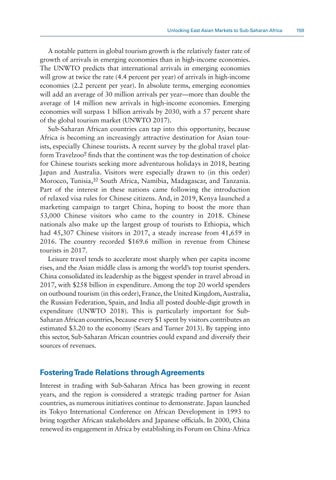Unlocking East Asian Markets to Sub-Saharan Africa 159
A notable pattern in global tourism growth is the relatively faster rate of growth of arrivals in emerging economies than in high-income economies. The UNWTO predicts that international arrivals in emerging economies will grow at twice the rate (4.4 percent per year) of arrivals in high-income economies (2.2 percent per year). In absolute terms, emerging economies will add an average of 30 million arrivals per year—more than double the average of 14 million new arrivals in high-income economies. Emerging economies will surpass 1 billion arrivals by 2030, with a 57 percent share of the global tourism market (UNWTO 2017). Sub-Saharan African countries can tap into this opportunity, because Africa is becoming an increasingly attractive destination for Asian tourists, especially Chinese tourists. A recent survey by the global travel platform Travelzoo9 finds that the continent was the top destination of choice for Chinese tourists seeking more adventurous holidays in 2018, beating Japan and Australia. Visitors were especially drawn to (in this order) Morocco, Tunisia,10 South Africa, Namibia, Madagascar, and Tanzania. Part of the interest in these nations came following the introduction of relaxed visa rules for Chinese citizens. And, in 2019, Kenya launched a marketing campaign to target China, hoping to boost the more than 53,000 Chinese visitors who came to the country in 2018. Chinese nationals also make up the largest group of tourists to Ethiopia, which had 45,307 Chinese visitors in 2017, a steady increase from 41,659 in 2016. The country recorded $169.6 million in revenue from Chinese tourists in 2017. Leisure travel tends to accelerate most sharply when per capita income rises, and the Asian middle class is among the world’s top tourist spenders. China consolidated its leadership as the biggest spender in travel abroad in 2017, with $258 billion in expenditure. Among the top 20 world spenders on outbound tourism (in this order), France, the United Kingdom, Australia, the Russian Federation, Spain, and India all posted double-digit growth in expenditure (UNWTO 2018). This is particularly important for SubSaharan African countries, because every $1 spent by visitors contributes an estimated $3.20 to the economy (Sears and Turner 2013). By tapping into this sector, Sub-Saharan African countries could expand and diversify their sources of revenues.
Fostering Trade Relations through Agreements Interest in trading with Sub-Saharan Africa has been growing in recent years, and the region is considered a strategic trading partner for Asian countries, as numerous initiatives continue to demonstrate. Japan launched its Tokyo International Conference on African Development in 1993 to bring together African stakeholders and Japanese officials. In 2000, China renewed its engagement in Africa by establishing its Forum on China-Africa


